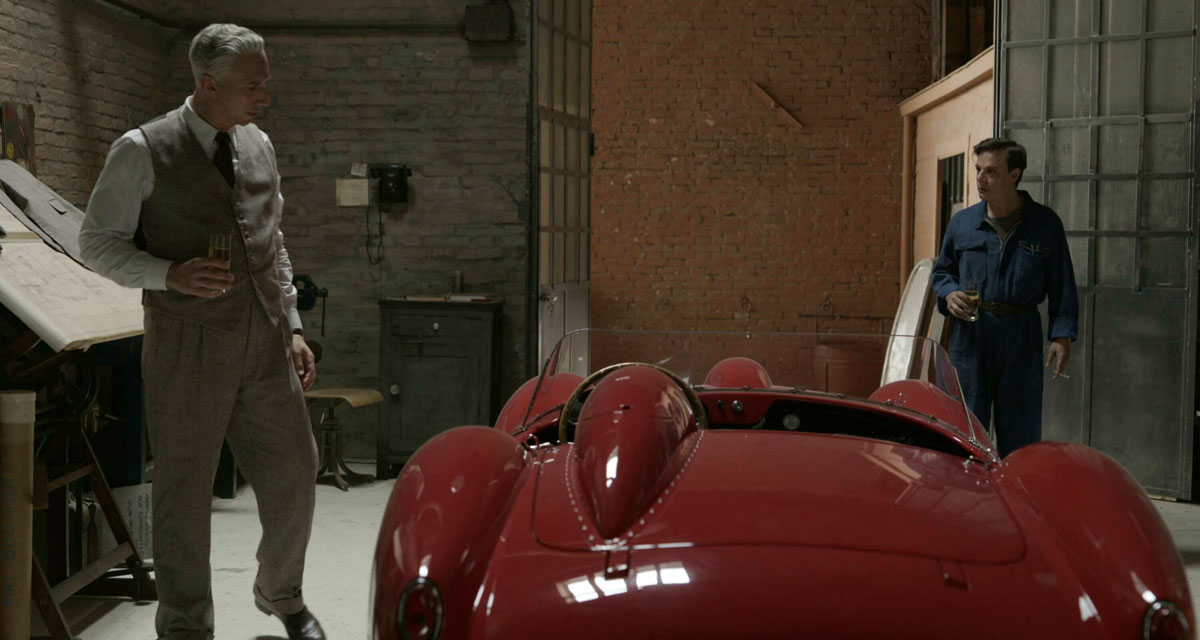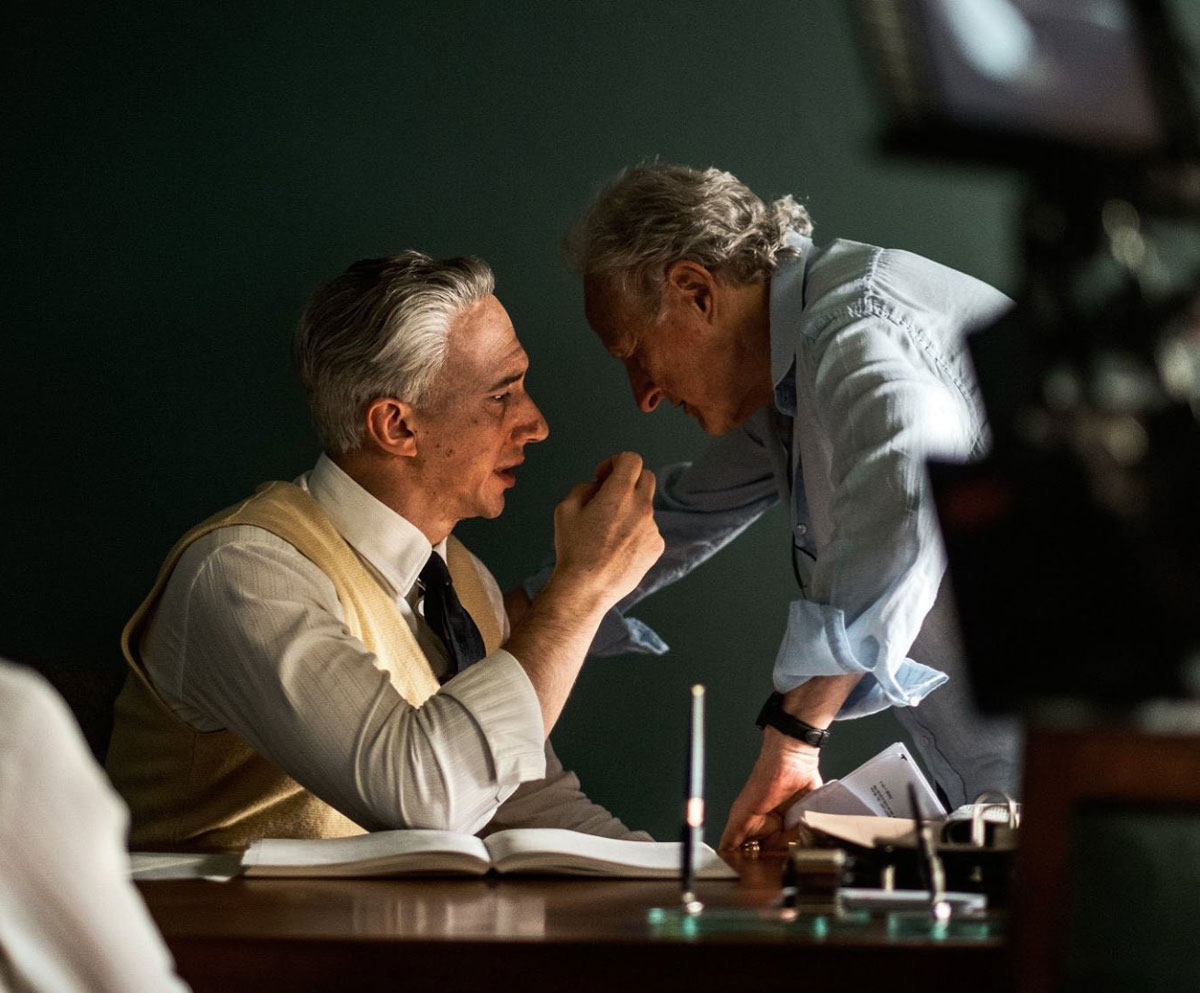A special advance look at a new $11 million horror offering, directed by Michael Mann
Report by Alan Jones
“Request immediate relocation. Something is murdering my men”. So goes the message sent by Captain Klaus Woermann to the German Army High Command, from a medieval fortress high in the Transylvanian Alps. This is the starling point for F. Paul Wilson’s best-selling novel “The Keep” but anyone expecting a straight translation of this Nazi vs The Supernatural story to the screen come the opening date sometime in September clearly hasn’t come across director Michael Mann, or his very definite views on the subject.
“Let’s face it, the book was very messy. I saw more potential than the existing application. The novel was the usual sort of solid gothic horror and I wanted to something much more expressionistic and basically make the whole thing as a dream. You don’t attempt to explain causes for happenings in a dream, or a fairytale for that matter, as everything works on a subconscious level What happens in The Keep is that all the entities have the logic power of a nightmare. I didn’t want to scare people by the usual obvious means. I’m not interested in showing a vulnerable person go into a dark room where I have established the monster is. That’s carnival stuff. I don’t want to see that and I don’t feel you will want to see all those cliches again either. What touches people more deeply are nightmares and the rules of logic that operate in such a landscape. One of the most frightening aspects of my film are the rules are not consistent. What appears to be the rule for two events isn’t true about a third It is that sort of randomness I find appealing and why I do feel The Keep is a fairy tale for grownups”.
The Keep is really the second feature film from Michael Mann as his first, Thief (renamed in Britain as Violent Streets) was preceeded by The Jericho Mile which was originally a movie made for television. The ecstatic reviews for Thief meant Mann turned down in the region of 270 screenplays before he decided on The Keep for keeps. Producers Gene Kirkwood and Howard Koch Jr had bought the Wilson property and saw more in the premise than the actual story concerning a Super Dracula against the SS set in Rumania, circa 1941. And Michael Mann agreed with them when he realised they, and Paramount pictures, had no desire to make an exploitation film.
“I mean the vampires were out immediately. It’s nonsense and it has all been seen before and I’m just not interested in doing something that has been seen before or a variation on that theme. This is a very ambitious film to make as I want to make you feel in ways you only feel once every two months or so when you have had an erotic dream or terrifying fantasy. The mechanism of events, as I see the story now, are repressed urges and desires in the unconscious mind that has to motivate the characters themselves in the story events themselves. And that is quite a departure from the book.”
So Michael Mann’s version of The Keep goes something like this … Captain Woermann, (played by Jurgen Prochnow who scored heavily in The Boat) and his unit enter the Keep and realise it was built not to keep anything out … but to keep something in. That something is Molasar, an age old force of unspeakable evil that must never be allowed to roam the world again. Glaeken Trismegestus, The Watchman (Scott Glenn) has to make sure of that and it is the events that are about to happen at the Keep that has been his destiny through countless centuries of craving mortality. Bewildered by the amount of strange occurrences and senseless killings that have happened since they entered the Keep, the Germans take, from a concentration camp, Dr Theodore Cuza (Ian McKellan), an expert on medieval history, and his daughter Eva (Alberta Watson) to see if they can come up with any answers other than the superstitions of the nearby villagers. When Cuza encounters what has been released within the walls of the Keep and sees how it resurrects his youth and strength, all plans of escape are abandoned as he realises he holds the key to smash the Nazi regime. All Molasar want Cuza to do is remove one object from the Keep, and he will help Cuza to that end. But that is the event The Watchman must never allow to happen, even though he is smitten by that most mortal of emotions – love for Cuza’s daughter.
“There is a moment in time when the unconscious of people is externalised. In the case of the 20th Century this time was the Fall of 1941. And the dark psychotic appeal underlying the slogans and rationalisations was making itself manifest: the concentration camps were being made ready. And this setting, that Paul Wilson chose for his story, works very well in the context of a fairystory for adults. I don’t know what Wilson thinks about my changes to his story. We talked briefly and he did send a telex with some suggestions but when we are making a movie, we are doing just that. The book is the raw material to change into what the movie has to be”.
In keeping with Mann’s character, The Keep is being made according to the new norm of budgetary and scheduling discipline. The film started shooting last September and had to make the answer print deadline of May 6th as set by Paramount who put up the tight 11 million dollar budget. The logistics of the twelve week shoot at Shepperton Studios and a quarry in Wales meant that Mann had four standby sets to run between in case anything went wrong on the first take. For this reason also, the scoring by Tangerine Dream, who also wrote the music for Thief, and the optical effects under veteran Wally Veevers were carried out concurrently with the main shooting.
The major special effect, of course, is Molasar, and that is being kept under tight wraps until the movie opens but from the information at hand it would seem to be a fibre-optically enhanced glowing brain that goes through three stages of metamorphosis into a muscular humanoid shape.
“Yes, that’s correct, he does go through three stages of evolution and it is only at the very end that he becomes almost complete. He was very Lovecraftian in the book and totally unbelievable as a result. I have Molasar’s character changing because of thematic reasons. He is ultimate evil and he gains substance throughout the film because of the very psychopathology of evil. For me evil is simple. It is a psychosis made manifest in a world of men until it impacts on their lives – it’s a mental disease turned into politics. I represent all of that allegorically and it may be too complex for a lot of people but that is the architecture I have to go through – that is internal to me – to have an understanding of what he should look like. I have to know what colour he is, how he walks and the colour of his eyes – I have to know all that minute detail so I can construct the film prescence. You aren’t necessarily going to pick up on all of that but I have to purvey a feeling and do the deductive reasoning to get a response from the audience because what you feel about Molasar determines all. The back of his head will shape other images in recall like World War 1 Austrian helmets. That’s the sort of visual tricky language I’m talking about and I don’t want to make the mistake of relying on dialogue to create that stuff because that is the biggest one – you can make”.
In Thief everything was wet, shiny and highly reflective and, according to Mann, rendered in a flat Pizarro perspective with touches of Kurosawa. The Keep is totally different in the fact that it is dry. “Very dry indeed. Here I’ve recalled German expressionism of the 1920s. It never rains in the Keep itself and death is dry. Life gets sucked out here, and there is a lot blackness. That is what death is to me – a blackened, charcoal brittle corpse-carbon fried matter with the absence of everything including bacteria. You will see hardly any red blood at all in The Keep. I’m not interested in gore. I want to make something that is powerful and the point in doing something different like this is that if it is fresh and new in approach it will affect an audience much more. I want to affect them with my impression of death in the same way they were affected by blood the first time they saw it. I’m exploring new channels of shock primarily for that reason. Let’s face it, The Thing was the ultimate prosthetic movie so that isn’t going to be an area to consider anymore. It was gratuitous and not very exciting speaking personally. The Keep is a new way of frightening you – Badly”.
Starring in The Keep as the enigmatic stranger Glaeken Trismegestus, is Scott Glenn who was recently shown to very good effect in The Challenge. Mann offered him the role because of his quality to exude tremendous reserved power with very little gesture and the fact that he is relatively unknown on these shores is something that will change in the very near future according to Mann’s reasoning. “What constitutes a star these days is a directive from the industry heads in Los Angeles usually three years before it is perceived as fact with the public. Being an industry movie star means your pay quadruples and you are offered six times more scripts. The heat about his new film The Right Stuff means the public will catch on very soon indeed”.
The top notch crew assembled for The Keep includes veteran, four time Oscar winner, production designer John Box, director of photography Alex Thomson, whose work on Excalibur so impressed Michael Mann, and one of Britain’s most respected mechanical effects supervisors, Nick Allder.
Along with all the other crew members, Allder was at first startled by Michael Mann’s abundance of energy and penchant for excessive working hours, but like everyone else he soon adapted.
“Every day is a minor panic with Michael. You plan everything. You talk to him in depth – and then at the last minute he sees something he’s never seen before and decides to give it a whirl. And of course we have to do it. He’s lovely to work with but very hard work. In actual fact there is a tremendous similarity between Michael’s working style and that of Ridley Scott. Both have great visual sense and an energy level that is quite shattering”.
Apart from creating all the atmospheric effects like wind and rain, Allder has utilised a lot of pyro-technics for the various methods of dispatching the marauding Nazis.
“I’ve had to very violently smash people against the wall, decapitate their heads and explode their bodies into a million pieces. The departure here of course is that there is no blood. All the victims have to look drained and so the charred masses we came up with are very effective. Before we started on the picture, Michael showed me some photos of bloated bodies from World War 2 and told us that was the anti-matter look he wanted. It may sound easy to do but the absence of any blood made it quite difficult in a way, as you can hide a lot with blood. It is often a lifesaver in our profession”.
The tremendously exciting climax aside, where The Watchman bleeds flourescent blood as he connects a talisman to a light sabre shaft and covers the interior of the Keep with a grid of laser lights reflecting off embedded melting crucifixes, the major effect Adder has been working on is the look and “power” of the evil Molasar. It has involved Adder constructing a huge 14 foot metal man that has been hung in one of the soundstages to portray the ever-growing power of the being.
“The 1¾ ton construction is full of metal pores through which we pass steam. As it is facing the ground, the steam loops around the body and tails off. When his footage is reversed and optically enhanced it looks like a constant stream of energy imploding on itself, which is precisely what we wanted to achieve. We couldn’t use smoke as it would just hang in the air. This footage is then overlaid with the live action shot on the set with an actor wearing a muscularised rubber suit. And although I say it myself it makes a very interesting effect indeed”.
One thing Nick Adder is certain of is that Michael Mann is definitely making a very unique picture indeed. “There were so many pitfalls in the story that could have relegated this project to the common or garden horror film that a lesser talent would have made. The Keep reminds me of Alien so much in that respect. I have funny beliefs in movies and I had the same feelings on Alien as I have with The Keep. I think it is going to be very good indeed – and I wasn’t wrong with Alien, was I?”
Perhaps, with The Keep, director Michael Mann, will reawaken those primal fears after all.
Starburst n. 58, June 1983; pp. 24-29



